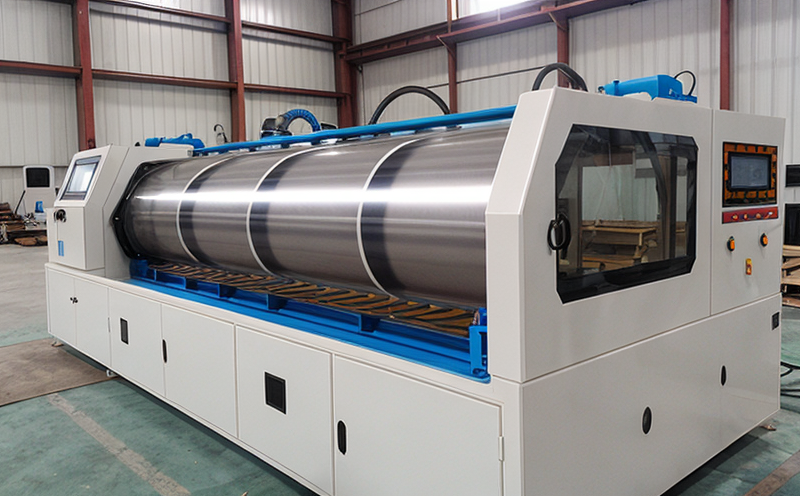ISO 4674-2 Coated fabrics Determination of tear resistance Part 2 Tongue tear method
The determination of tear resistance in coated fabrics is a critical aspect of quality control and compliance, particularly for sectors such as automotive, aerospace, construction, and industrial textiles. The ISO 4674-2 standard provides precise guidelines for the measurement of tear resistance using the tongue tear method. This method is essential in ensuring that coated fabrics can withstand various stresses encountered in real-world applications without failing.
The test involves cutting a small, triangular piece from the fabric (the "tongue") and measuring its ability to resist tearing under specific conditions. The standard specifies detailed procedures for sample preparation, testing setup, and data analysis to ensure consistency and reliability across different laboratories.
Sample preparation is critical in this process. A representative sample of the coated fabric must be cut into a precise geometric shape according to ISO 4674-2 specifications. This ensures that all tests are conducted under consistent conditions, which is vital for accurate comparisons between results from various labs and manufacturers.
The testing setup includes a specialized tensile testing machine capable of applying controlled forces perpendicular to the grain direction of the fabric. The specimen is clamped at its base, and the force required to initiate and propagate a tear through the specimen is measured. This measurement provides valuable insights into how well the fabric can withstand tearing stresses.
The results from this test are typically reported in terms of the maximum load (in Newtons) that the specimen can withstand before tearing occurs. These values are then compared against specified acceptance criteria, which vary depending on the intended use and performance requirements of the fabric. For instance, automotive upholstery fabrics may have stricter tolerances than industrial conveyor belts.
Understanding the importance of this test is crucial for quality managers, compliance officers, R&D engineers, and procurement teams involved in material selection and certification processes. By adhering to ISO 4674-2 standards, manufacturers can ensure that their products meet global quality benchmarks and regulatory requirements.
Real-world applications of this testing method include:
- Automotive interiors
- Aerospace components
- Construction materials
- Industrial conveyor belts
- Military textiles
The precision and reliability of the ISO 4674-2 standard make it a cornerstone for ensuring product integrity in coated fabrics. Compliance with this standard helps to reduce production defects, enhance customer satisfaction, and maintain a competitive edge in the market.
Why It Matters
The determination of tear resistance in coated fabrics using ISO 4674-2 is not just an academic exercise but has significant real-world implications. In sectors like automotive, aerospace, and construction, where materials are subjected to harsh environmental conditions and mechanical stresses, the ability to withstand tearing can be a matter of safety and performance.
For instance, in automotive interiors, coated fabrics used for seat upholstery must be robust enough to handle the weight and movement of passengers without tearing. Any failure could lead to discomfort or even injury. In aerospace applications, such as protective clothing or canopy covers, tear resistance is crucial for ensuring that materials can protect personnel from potential hazards.
The results of this test are also essential for regulatory compliance. Many industries have stringent standards and regulations governing the safety and performance of their products. Compliance with ISO 4674-2 ensures that manufacturers meet these requirements, thereby avoiding costly recalls and reputational damage.
From a technical perspective, the tongue tear method provides valuable data on how different coatings affect the tear resistance properties of fabrics. This information is invaluable for R&D teams looking to optimize materials and improve product performance. The test also aids in quality control by providing consistent and reproducible results that can be used to monitor production processes.
In summary, ISO 4674-2 plays a pivotal role in ensuring the safety, durability, and compliance of coated fabrics across various industries. By adhering to this standard, manufacturers can enhance their product quality, meet regulatory requirements, and gain a competitive advantage in the market.
Industry Applications
| Industry | Application |
|---|---|
| Aerospace | Protective clothing and canopy covers |
| Automotive | Seat upholstery, door panels, and roof linings |
| Construction | Roofing membranes and waterproofing fabrics |
| Industrial | Conveyor belts, hose reinforcement, and protective garments |
| Military | Ppe clothing and vehicle covers |
The versatility of coated fabrics makes them indispensable in various industries. The ISO 4674-2 method ensures that these materials can perform reliably under the most demanding conditions, enhancing safety and performance.
International Acceptance and Recognition
- ISO 4674-2 is widely recognized by global standards organizations such as ASTM, EN, IEC, and AS.
- The method is used in quality control processes across numerous industries to ensure product integrity.
- Many regulatory bodies reference ISO 4674-2 when setting performance criteria for coated fabrics.
- Manufacturers worldwide use this standard to demonstrate compliance with international standards.
- ISO 4674-2 is included in many national and regional regulations governing the safety and quality of textiles.
- The method has been adopted by numerous testing laboratories around the globe, ensuring consistent results across different regions.
The widespread acceptance of ISO 4674-2 highlights its importance in maintaining high standards for coated fabrics. Compliance with this standard is a testament to a manufacturer's commitment to quality and safety.





